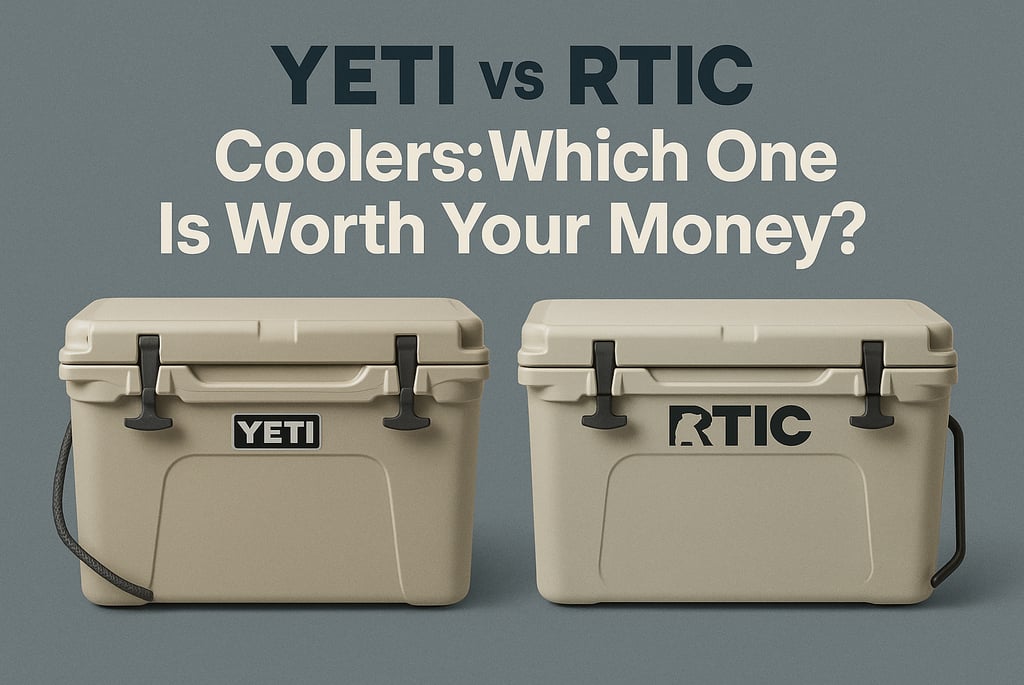RTIC vs YETI Coolers: Honest Review from a Camper Who’s Tried Both
Can a budget‑friendly RTIC compete with a premium YETI cooler? Here’s my honest review comparing their performance, ice retention, and price after using both for camping and road trips.
RV KITCHEN ESSENTIALS
8/4/20252 min read


If you’re anything like me, you’ve probably spent way too much time comparing coolers online. When I first started camping regularly, I quickly realized that the little department‑store coolers just weren’t cutting it—especially on longer trips or hot summer days. That’s when I dove into the world of “serious coolers,” and like most people, I landed on two big names: YETI and RTIC.
I’ve now spent plenty of weekends camping, tailgating, and road‑tripping with both brands, and I thought I’d share my honest thoughts. If you’ve been wondering which one is actually worth your money, here’s my take.
First Impressions: Premium vs. Practical
When my first YETI Tundra 45 arrived, I won’t lie—I felt a little fancy. The build quality is incredible. The latches are smooth, the rope handles feel solid, and the whole thing just screams “premium.” But at over $300, I definitely felt it in my wallet.
A few months later, I tried out an RTIC 45 Quart (because I wanted a backup for big group trips). It cost me about 40% less than the YETI—and to my surprise, it didn’t feel cheap at all. The design was almost identical, and it came with some thoughtful extras like integrated tie‑down points and dual drain plugs.
How They Actually Perform
Here’s the thing: in day‑to‑day use, both do their job really well. I did a little side‑by‑side experiment during a long weekend camping trip.
I pre‑chilled both coolers overnight, packed them with the same amount of ice and drinks, and left them in the same spot at camp.
YETI definitely kept ice a little longer—about 8–10 extra hours before it started turning into slush.
RTIC, though, wasn’t far behind. And for how much I paid, I honestly didn’t mind topping up with a bag of ice sooner.
Unless you’re planning a week‑long backcountry trip with zero access to ice, the difference just isn’t as dramatic as the price tag suggests.
Features I Actually Use
YETI: I love the non‑slip feet (seriously, it stays put even in my van), the thicker gasket seal, and the overall durability. It just feels bulletproof.
RTIC: I’m a fan of the slightly bigger interior capacity. For the same “size” rating, the RTIC usually holds a few more cans. And their dual‑drain system? Super handy when you need to get rid of melted ice without tilting the cooler.
So, Which One Would I Recommend?
Here’s my honest take:
If you want top‑notch insulation, brand prestige, and a 5‑year warranty—and don’t mind paying for it—go with YETI.
If you want a great cooler for significantly less money (and can live with slightly less ice retention), RTIC is a fantastic value.
For me? I actually keep both. I use the YETI for long trips when I need it to hold ice as long as possible, and I bring the RTIC for casual weekends or as a “drinks only” cooler.
Final Thoughts
At the end of the day, you really can’t go wrong with either. It just comes down to how much you’re willing to spend for those extra hours of ice retention and that “premium feel.”
If you’re budget‑conscious, RTIC will make you very happy. If you want the “buy it once and never think about it again” option, YETI is worth the splurge.
Explore
Trailside Stories shares honest reviews, tips, and stories from our outdoor camping and hiking adventures in our Mercedes camper van. Some links on this site are affiliate links, meaning we may earn a small commission at no extra cost to you. We only recommend products we personally use and trust.
Journey
© 2025. All rights reserved.
